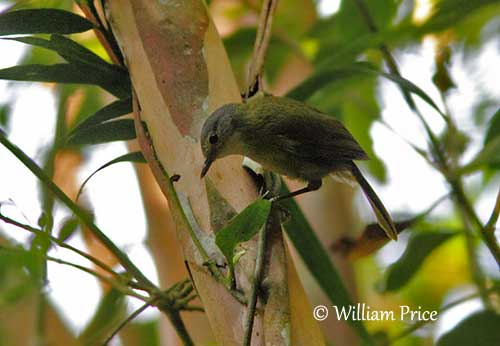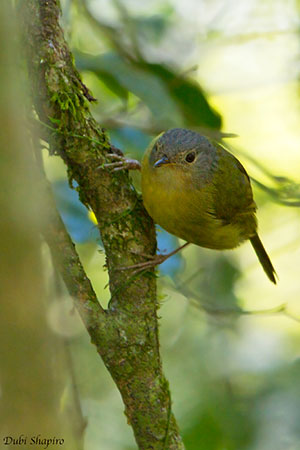
The breeding behaviour of this species is poorly known. From an observation of three adults feeding two chicks in a nest, the Grey-crowned Tetraka may be a co-operative breeder. But more information is required.
The species is presumably sedentary on Madagascar.
It is agile in flight. It moves from tree to tree while foraging, with strong, undulating flight.
REPRODUCTION OF THIS SPECIES:
The Grey-crowned Tetraka is recorded nesting in November. It builds a cup-shaped nest with moss. The cup is lined with dry grass and plant fibres. It is placed in the horizontal fork of a small branch, 1-2 metres above the ground.
The female lays three eggs. No more information.
PROTECTION / THREATS / STATUS:
The Grey-crowned Tetraka is restricted to the humid eastern forest where it can be fairly common. But it has restricted altitudinal range. Habitat loss and forest destruction for agriculture expansion involve some decline in the small population. However, this species occurs in several protected areas such as national parks and reserves.
The Grey-crowned Tetraka is currently listed as Near Threatened.
Fr: Bulbul à tête grise
Ang: Grey-crowned Tetraka
All: Grauscheitelbülbül
Esp: Bulbul Coronigrís
Ita: Bulverde capogrigio
Nd: Grijskruintetraka
Sd: gråkronad tetraka
Mal: Farifotra, Farifotramavoloha
Photographer:
William Price
PBase-tereksandpiper & Flickr William Price
Dubi Shapiro
Dubi Shapiro Photo Galleries & Dubi Shapiro's Pictures on IBC
Text by Nicole Bouglouan
Sources:
HANDBOOK OF THE BIRDS OF THE WORLD Vol 10 by Josep del Hoyo-Andrew Elliott-David Christie - Lynx Edicions - ISBN: 8487334725
Birds of Madagascar and the Indian Ocean Islands Par Roger Safford, Adrian Skerrett, Frank Hawkins – ISBN: 1472924118, 9781472924117- Editeur: Bloomsbury Publishing, 2015
The Birds of Africa: Volume VIII: The Malagasy Region: Madagascar, Seychelles, Comoros, Mascarenes - Par Roger Safford, Frank Hawkins – ISBN: 1408190494, 9781408190494- Editeur: A&C Black, 2013
Wildlife of Madagascar par Ken Behrens, Keith Barnes - ISBN: 140088067X, 9781400880676 – Editeur: Princeton University Press, 2016
CREAGUS - MALAGASY WARBLERS Bernieridae
Fatbirder - Bernieridae - Malagasy Warblers
Wikipedia, the free encyclopaedia
Grey-crowned Tetraka
Xanthomixis cinereiceps
Passeriformes Order – Bernieridae Family
INTRODUCTION:
The Grey-crowned Tetraka is endemic to Madagascar. It is found in E and N of the island where it frequents the primary humid forest above 1,000 metres of elevation.
This species was formerly in the family Pycnonotidae, but following DNA analyses, it is now included in the family Bernieridae of the Malagasy warblers, endemic to Madagascar.
The Grey-crowned Tetraka is mainly an insect-eater. It forages in the understorey on mossy tree trunks and branches like a nuthatch. Some observations may suggest co-operative breeding.
The species depends on forest and is threatened by habitat loss through forest clearance and degradation of the habitat.
DESCRIPTION OF THE BIRD:
Biometrics:
Length: 14 cm
Weight: 13,5-24,5 g
On the upperparts, mantle and back are olive-green, but wings and tail are slightly darker. The flight feathers show pale yellow fringes to the leading edges.
On the underparts, chin and throat are whitish whereas breast and belly are yellow. Breast sides, flanks and undertail-coverts are darker olive-yellow.
On the head, forehead, crown, nape, hindneck and neck sides are dark grey, giving the bird its name. Lores are paler greyish-brown. Cheeks and ear-coverts are blue-grey with fine pale streaking.
The bill is dark grey with pale pink base on lower mandible. This mandible appears slightly upcurved at tip, and slightly inflated centrally. The eyes are brown. Legs and feet are pale grey.
Male and female are similar, with the female slightly smaller than male.
The juvenile is grey-green above and dull buffy below. The throat may appear paler. The crown will become greyer later.

RANGE:
The Grey-crowned Tetraka is found in N and E Madagascar, S to Andohahela.
HABITAT:
The Grey-crowned Tetraka frequents the eastern humid forests between 800 and 2,000 metres of elevation, but mainly between 1,000 and 1,400 metres. However, it does not frequent disturbed forest. Its predilection for moss-covered trunks explains why it is rare below 800-1,000 metres where the moss growth is limited.
CALLS AND SONGS: SOUNDS BY XENO-CANTO
The Grey-crowned Tetraka’s call is a series of high-pitched, tiny “tsip” and short explosive trills.
The song is often given from perch, a series of explosive and liquid notes.
BEHAVIOUR IN THE WILD:
The Grey-crowned Tetraka feeds mainly on insects. It forages like a nuthatch by climbing vertical mossy tree trunks and branches up to 15 metres above the ground. It flies from tree to tree in undulating fashion. It lands at base of the trunk and climbs while searching for invertebrates in the moss.
It also forages in small shrubs among twigs or leaves, but also on the ground where it examines carefully the mossy stones.
